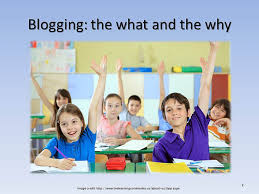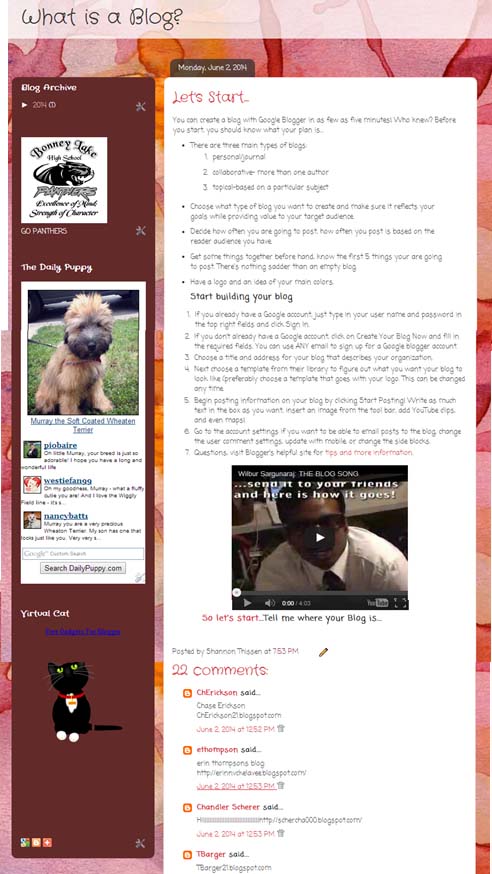
Question for ISTE Standard 2: How can I design authentic learning environments in a high school classroom that allows for students to actively participate in setting their own goals, manage their own learning, and evaluate their own progress? The article I chose is “Teaching with technology: Tools and strategies to improve student learning”, J. Orlando and “The ultimate guide to the use of blogs in teaching” from the Educational Technology and Mobile learning Website.
The first article compared Learning Management Systems with Blogs. Learning Management Systems (LMS) such as Moodle, Blackboard, and 3DGameLab are often used because instructors believe they are integrating technology into their curriculum. In reality all we are doing is spending hours of set-up for both student use and curriculum integration to ultimately present the same content in a different way. The systems are the holder of the content, allowing for “topic centered discussion” (Orlando 2011) and viewed by only one other person, the instructor.
A blog which is more like a journal or forum for students to demonstrate their knowledge and understanding or thoughts on the material. The blog is just another digital medium for presenting learning, and not all students will find this appealing. These are in a public space, one in which everyone can see. Understanding this students take more time in reviewing and polishing the content for their “audience”. Each “Blogger” (Educational Technology and Mobile Learning) is the creator of their own content so they become more invested in how their digital identity is viewed.
VIDEO: Blogs in Plain English (Evaluation Copy) by Common Craft.
The real power comes in the form of the comments. Comments contribute to the student ideas, thoughts and insights about their work, communicating with the entire learning community. Receiving feedback from peers and the instructor, allowing for higher order thinking skills such as analyzing and comparing. But before you get to the classroom, there are several issues that you must address (Educational Technology and Mobile Learning). Because of the public nature, parents need to be notified of what you are doing and why, they must give their consent for blog use. As far as creating a Blog, this is different for each school district. Schools that have adopted the Google Education Sites, have access to Blogger, one of the blogging websites.
I have a “Blog Creation” assignment that I use with my students, usually at the end of the year. What I have done is to first teach students a classroom protocol. I have created a set of standards or ethics that constrain the information presented to that which is school appropriate and content applicable. Instruction is key to students presenting what is appropriate, within basic educational expectations and online safety. The other concerns we as teachers have is shared by Sarah, who is in my learning circle, her concern: “How much time/how much content the teacher would need to keep track of all the discussions, it could be daunting to keep track of and grade everything.”
I understand the concern, but believe that by allowing students the freedom to express where they are in their learning also means as a teacher, I have some freedom from using the tool as a summative assessment. Instead, it has become a great formative assessment. I am able to get an authentic look into the student’s thoughts and understandings in a way that is non-threatening. Of course I can create some assignments that are summative and part of the blog, but I limited them to a required set of competencies, and a clearly defined rubric. As I have most of my classes, creating their reflection in a standard document, which becomes stagnate, I believe that I can get a better picture of their growth by integrating the blog from the beginning.
I already have a Blog that I use for my Blog assignment, a screenshot is below. I can use this as a start in all my classes, it’s going to be interesting and fun to evaluate what happens.
Educational Technology and Mobile Learning. (2014, October 24). The Ultimate Guide to The Use of Blogs in Teaching. Retrieved from http://www.educatorstechnology.com/2012/06/ultimate-guide-to-use-of-blogs-in.html
Orlando, J. 2011. Teaching with Technology: Tools and strategies to improve student learning. Faculty Focus, 1-16.
I also try to have some fun, the kids know I am pretty reserved so I inserted a funny/silly/annoying little YouTube clip. It’s old and I can’t remember how I found it, but it gets their attention and a little eye-rolling (OK, a lot of eye-rolling). So a really bad attempt at humor…
Blog Song: https://www.youtube.com/watch?v=nyeJ2dhtvjQ

Hi Shannon,
You have officially got me interested in blogs for the classroom. What hooked me was when you said “These are in a public space, one in which everyone can see. Understanding this students take more time in reviewing and polishing the content for their “audience”” Before, I thought of blogs as this no-rules arena but now you have me thinking along the lines of journals. My students keep an old-school composition notebook that we use for various activities, including journals, but they don’t all have to share every week–and they don’t all write their 1/2 page required entry. Perhaps using a blog would push the kids to write more detailed entries and work on their voice because, like you said, it’s public and everyone can see.
I love that there are blogging programs for free and they seem user friendly. It seems like an interesting way for the students to practice communicating.
Would you discuss posts in class? Or keep the blog portion of the course strictly homework/outside of class time?
Thanks for the information!
Sara H.
I have not had students discuss posts of their own in class, but discussing the posts of other more popular blogs that address the course content works well. I do require my students to post responses to prompts on each others blogs. It works out to be a good reflective process where they can demonstrate their understandings of essential questions applicable to the content.
Part of my Blog creating instruction includes moderating. They are required to operate under a process where they must accept appropriate posts and deny/ignore inappropriate ones. They still think that they can sabotage each other through inappropriate comments but making them moderate help defer/delete those comments they don’t want to effect their grade. Not following moderating policies is a good way to lose points.
But, no matter what there always is one student…..